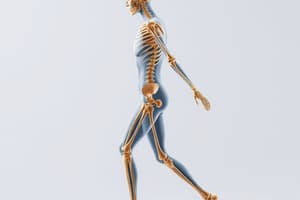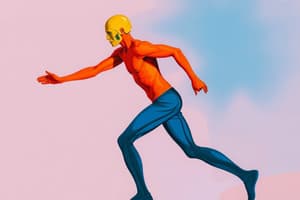Podcast
Questions and Answers
What is the primary function of the knee extensors during stair ascent?
What is the primary function of the knee extensors during stair ascent?
- To generate most of the energy to move the body forward (correct)
- To facilitate the swing phase by flexing the knee
- To generate eccentric force for energy absorption
- To halt forward motion during foot placement
Which phase of the sit to stand movement begins just before the buttocks are lifted from the seat?
Which phase of the sit to stand movement begins just before the buttocks are lifted from the seat?
- Weight shift or flexion momentum (correct)
- Lift or extension
- Transfer of momentum
- Stabilization phase
During the controlled descent phase of stair walking, which muscle groups are primarily engaged?
During the controlled descent phase of stair walking, which muscle groups are primarily engaged?
- Hamstrings and soleus muscles
- Eccentric contractions of the gastrocnemius and quadriceps (correct)
- Hip flexors and quadriceps
- Ankle dorsiflexors and tibialis anterior
How does the use of armrests affect the sit to stand movement?
How does the use of armrests affect the sit to stand movement?
What characterizes the initial impact forces during the running gait cycle?
What characterizes the initial impact forces during the running gait cycle?
Which aspect does NOT fall under the movement continuum?
Which aspect does NOT fall under the movement continuum?
What is a potential outcome if the expected performance is not achieved during a movement task?
What is a potential outcome if the expected performance is not achieved during a movement task?
Which of the following is an example of an environmental regression?
Which of the following is an example of an environmental regression?
In the structured movement analysis framework, what is the primary focus during the observation phase?
In the structured movement analysis framework, what is the primary focus during the observation phase?
What does the term 'initial conditions' refer to in the movement continuum?
What does the term 'initial conditions' refer to in the movement continuum?
Which cueing method typically requires the least amount of assistance during task performance?
Which cueing method typically requires the least amount of assistance during task performance?
What is a characteristic of task progressions in structured movement analysis?
What is a characteristic of task progressions in structured movement analysis?
Which action is required for the step up/down task?
Which action is required for the step up/down task?
What is the main objective of the walking task as described?
What is the main objective of the walking task as described?
Which of the following is NOT a requirement for the standing task?
Which of the following is NOT a requirement for the standing task?
In the reach/grasp/manipulate task, how far is the cup placed from the person?
In the reach/grasp/manipulate task, how far is the cup placed from the person?
What is the expected outcome when performing the reach/grasp/manipulate task?
What is the expected outcome when performing the reach/grasp/manipulate task?
For the reach/grasp/manipulate task, which position should the person be in at the start?
For the reach/grasp/manipulate task, which position should the person be in at the start?
During the standing task, what is the primary guidance given regarding hand use?
During the standing task, what is the primary guidance given regarding hand use?
What type of surface is required for the standing task?
What type of surface is required for the standing task?
Which leg should lead when stepping down during the step up/down task?
Which leg should lead when stepping down during the step up/down task?
What is a crucial instruction for the walking task?
What is a crucial instruction for the walking task?
Flashcards
Structured Movement Analysis
Structured Movement Analysis
A structured way to observe natural movement patterns and strategies during a task, aiming to understand movement dysfunction.
Movement Continuum
Movement Continuum
A framework for organizing movement observations, from initial conditions through initiation, execution, termination, and outcome.
Task Regression
Task Regression
Simplifying a task to make it less challenging, improving success in performing the task.
Task Progression
Task Progression
Signup and view all the flashcards
Initial Conditions stage
Initial Conditions stage
Signup and view all the flashcards
Cueing
Cueing
Signup and view all the flashcards
Sitting Task Description
Sitting Task Description
Signup and view all the flashcards
Standing Task
Standing Task
Signup and view all the flashcards
Walking Task
Walking Task
Signup and view all the flashcards
Step Up/Down Task
Step Up/Down Task
Signup and view all the flashcards
Step Height
Step Height
Signup and view all the flashcards
Reach/Grasp Task
Reach/Grasp Task
Signup and view all the flashcards
Base of Support
Base of Support
Signup and view all the flashcards
Task Instructions
Task Instructions
Signup and view all the flashcards
Walking Distance
Walking Distance
Signup and view all the flashcards
Cup Placement
Cup Placement
Signup and view all the flashcards
Receptacle location
Receptacle location
Signup and view all the flashcards
Stair Ascent Force
Stair Ascent Force
Signup and view all the flashcards
Stair Descent Weight Acceptance
Stair Descent Weight Acceptance
Signup and view all the flashcards
Sit-to-Stand Momentum Transfer
Sit-to-Stand Momentum Transfer
Signup and view all the flashcards
Sit-to-Stand Chair Height
Sit-to-Stand Chair Height
Signup and view all the flashcards
Rolling Supine to Prone
Rolling Supine to Prone
Signup and view all the flashcards




